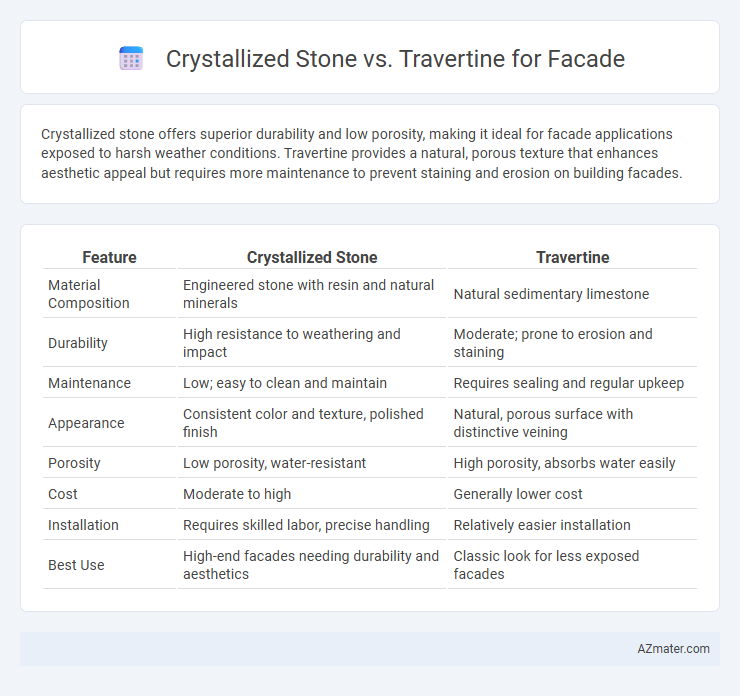Crystallized stone offers superior durability and low porosity, making it ideal for facade applications exposed to harsh weather conditions. Travertine provides a natural, porous texture that enhances aesthetic appeal but requires more maintenance to prevent staining and erosion on building facades.
Table of Comparison
| Feature | Crystallized Stone | Travertine |
|---|---|---|
| Material Composition | Engineered stone with resin and natural minerals | Natural sedimentary limestone |
| Durability | High resistance to weathering and impact | Moderate; prone to erosion and staining |
| Maintenance | Low; easy to clean and maintain | Requires sealing and regular upkeep |
| Appearance | Consistent color and texture, polished finish | Natural, porous surface with distinctive veining |
| Porosity | Low porosity, water-resistant | High porosity, absorbs water easily |
| Cost | Moderate to high | Generally lower cost |
| Installation | Requires skilled labor, precise handling | Relatively easier installation |
| Best Use | High-end facades needing durability and aesthetics | Classic look for less exposed facades |
Introduction to Crystallized Stone and Travertine Facades
Crystallized stone facades offer enhanced durability and low porosity, making them resistant to weathering and pollution, suitable for modern architectural designs. Travertine facades provide a classic and natural aesthetic with porous textures that require sealing and maintenance to preserve their appearance and structural integrity. Both materials serve distinct roles in facade applications, balancing strength, visual appeal, and upkeep requirements in exterior cladding solutions.
Composition and Formation: Crystallized Stone vs Travertine
Crystallized stone is primarily formed through the recrystallization of natural minerals under intense heat and pressure, resulting in a dense, non-porous surface composed mainly of quartz or other silicate minerals. Travertine, on the other hand, is a form of sedimentary limestone deposited by mineral springs, characterized by its porous texture and composed mainly of calcium carbonate. The differing formation processes and compositions of crystallized stone and travertine directly impact their durability, porosity, and suitability for facade applications.
Aesthetic Differences: Texture, Color, and Finish
Crystallized stone exhibits a smooth, glass-like texture with a high-gloss finish that enhances its vibrant, uniform color, making it ideal for sleek, modern facades. Travertine features a natural, porous texture with earthy tones ranging from beige to rust, offering a warm, rustic aesthetic with a matte or honed finish. The choice between the two depends on desired visual impact: crystallized stone delivers a polished, contemporary look, while travertine provides organic, textured character.
Durability and Weather Resistance Comparison
Crystallized stone offers superior durability and enhanced weather resistance compared to travertine, making it ideal for facades exposed to harsh climates. Its dense, non-porous structure resists water absorption and prevents erosion, while travertine's porous nature often leads to faster degradation and staining under prolonged weather exposure. This makes crystallized stone a more long-lasting and low-maintenance choice for exterior architectural surfaces.
Maintenance and Cleaning Requirements
Crystallized stone facades offer superior resistance to stains and scratches, requiring minimal regular maintenance and simple cleaning with mild detergents and water. Travertine, a porous natural stone, demands periodic sealing to prevent moisture absorption, and its cleaning involves gentle techniques to avoid surface erosion and discoloration. Consistent upkeep is essential for travertine to maintain its aesthetic appeal, while crystallized stone provides a more durable, low-maintenance option for exterior cladding.
Cost Analysis: Installation and Long-Term Value
Crystallized stone offers higher initial installation costs due to specialized cutting and sealing processes compared to travertine, which is typically easier and less expensive to install. Travertine may require more frequent maintenance and sealing to prevent staining and weather damage, potentially increasing long-term expenses. In contrast, crystallized stone's durability and resistance to weathering contribute to lower maintenance costs and better long-term value despite the higher upfront investment.
Environmental Impact and Sustainability
Crystallized stone, produced through advanced sintering technology, offers enhanced durability and low porosity, reducing maintenance frequency and resource consumption over time. Travertine, a natural sedimentary rock, involves quarrying practices that can significantly alter landscapes and generate higher carbon emissions due to transportation and extraction processes. Choosing crystallized stone supports sustainability goals by minimizing environmental disruption and extending facade lifespan through superior resistance to weathering and pollutants.
Application Versatility: Design Flexibility for Facades
Crystallized stone offers superior design flexibility for facades due to its ability to mimic various natural stones with enhanced durability and a polished finish suitable for modern architectural styles. Travertine, known for its porous texture and warm, earthy tones, provides a classic, timeless look but may require additional sealing for exterior use to maintain longevity. The choice between crystallized stone and travertine hinges on the desired aesthetic impact and maintenance tolerance, with crystallized stone excelling in versatile, high-traffic urban facade applications.
Performance in Various Climates
Crystallized stone exhibits superior resistance to moisture and temperature fluctuations, making it ideal for facades in both humid and cold climates, while Travertine tends to absorb water and may deteriorate faster in harsh weather conditions. The dense composition of Crystallized stone enhances durability against frost damage and thermal expansion, ensuring long-term stability in extreme climates. Travertine requires regular sealing and maintenance to prevent weathering, particularly in freeze-thaw environments and areas with heavy rainfall.
Choosing the Right Material: Key Considerations for Facade Projects
Crystallized stone offers superior durability and a polished aesthetic ideal for high-traffic facade projects, while travertine provides a natural, porous texture that enhances rustic or classic designs. Consider factors such as weather resistance, maintenance requirements, and color variation stability when selecting between the two materials to ensure long-term performance. Evaluating project location, budget constraints, and desired architectural style will guide the optimal choice for facades.

Infographic: Crystallized stone vs Travertine for Facade
 azmater.com
azmater.com